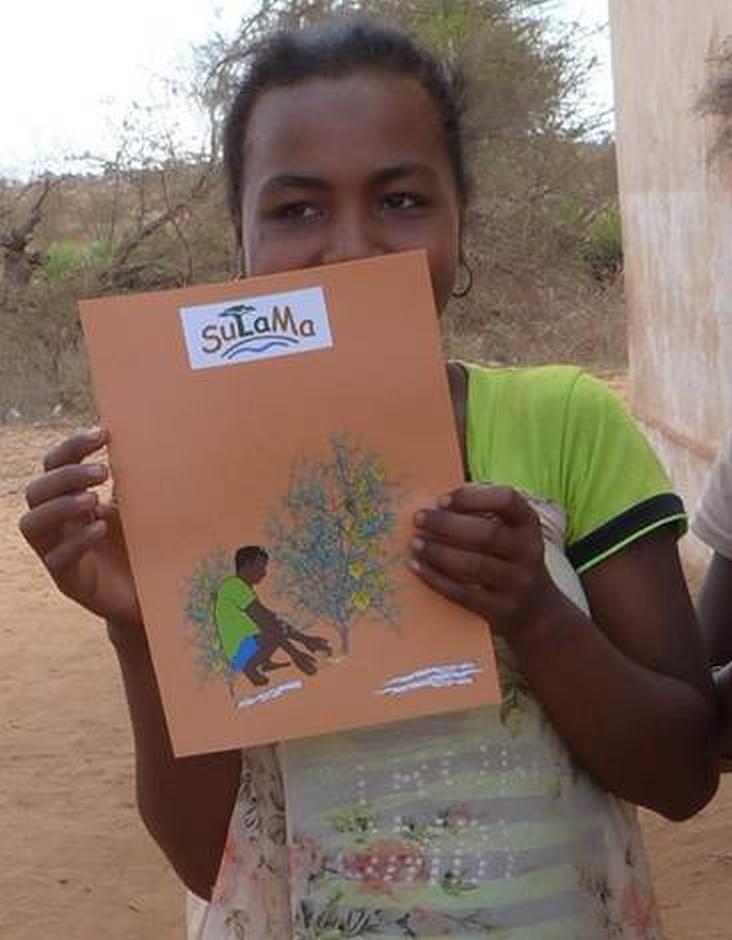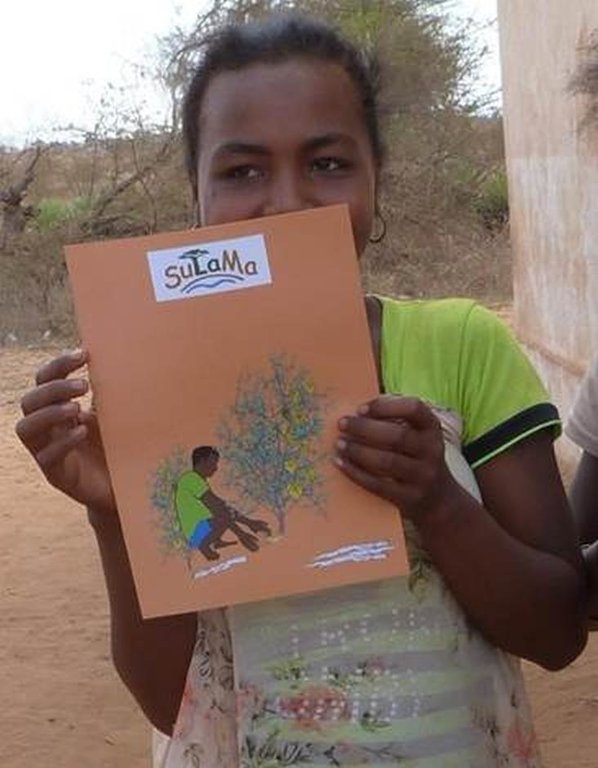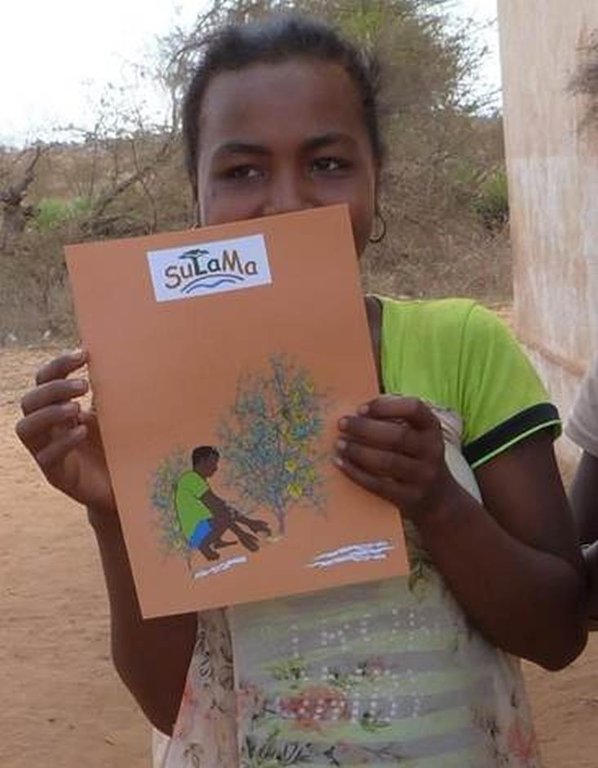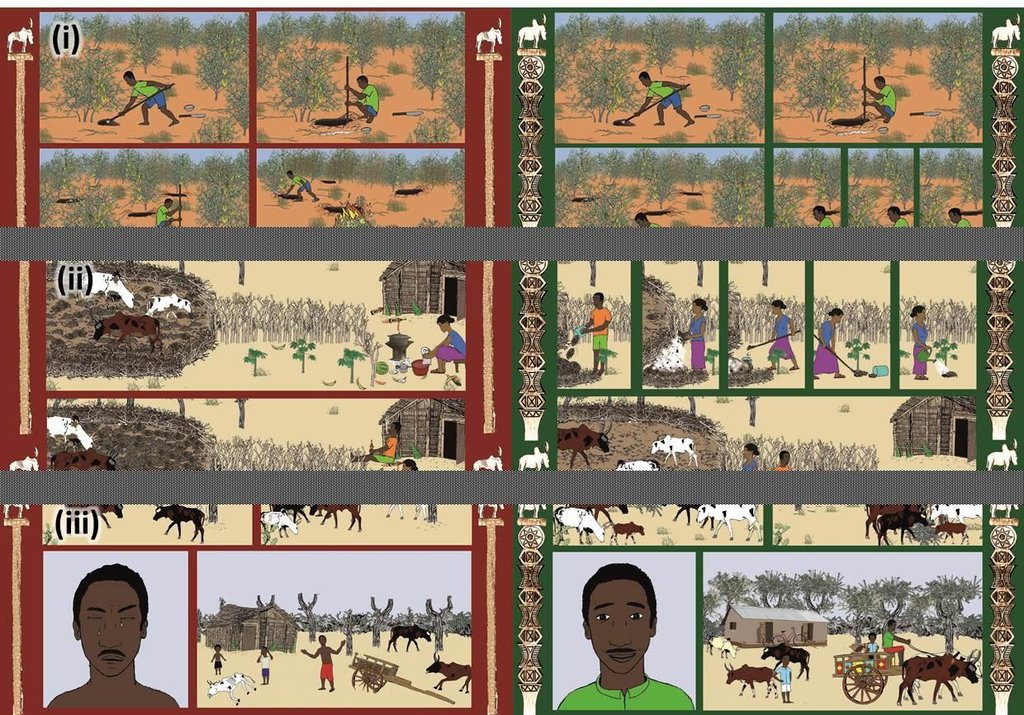Increasing environmental awareness using comic-style illustrations as a visual communication tool [Madagascar]
- Creation:
- Update:
- Compiler: Tobias Feldt
- Editor: –
- Reviewer: Fabian Ottiger
approaches_2545 - Madagascar
View sections
Expand all Collapse all1. General information
1.2 Contact details of resource persons and institutions involved in the assessment and documentation of the Approach
SLM specialist:
Weiss David
mail@david-weiss.com
David Weiss Agrarcomics
Kirchstraße 18, D-37214 Witzenhausen http://david-weiss.com
Germany
Name of project which facilitated the documentation/ evaluation of the Approach (if relevant)
Sustainable Landmanagement in south-western Madagascar (SuLaMa / GLUES)Name of the institution(s) which facilitated the documentation/ evaluation of the Approach (if relevant)
Universität Kassel - Germany1.3 Conditions regarding the use of data documented through WOCAT
When were the data compiled (in the field)?
01/10/2015
The compiler and key resource person(s) accept the conditions regarding the use of data documented through WOCAT:
Ja
1.4 Reference(s) to Questionnaire(s) on SLM Technologies
2. Description of the SLM Approach
2.1 Short description of the Approach
Communicating and transferring scientific results and recommendations about sustainable land management to local people
2.2 Detailed description of the Approach
Detailed description of the Approach:
Aims / objectives: The central aim of this approach was to increase environmental awareness in the Mahafaly region of southwestern Madagascar using visual communications tools. Comic-style illustrations were originally designed to communicate scientific recommendations on sustainable land management (SLM) and to ensure knowledge transfer from scientists to local people.
Methods: Visual communication, based on pictures, drawings, movies, sequential images and posters plays a vital role in countries where many people are illiterate. Another advantage is its easy reproduction in comparison to oral communication. It may also transfer knowledge where oral communication fails because of linguistic barriers or simply because complex narratives and messages are easier to explain visually than orally. In the context of a participatory research project to support SLM on the Mahafaly Plateau in southwestern Madagascar, comic-style illustrations of visual narratives were used to focus on environmental problems and SLM strategies. Since cross-cultural differences arise in “visual languages” globally, the visualization style needs to be carefully selected. Furthermore, misunderstanding of visual narratives may occur when objects are drawn not realistically enough, or if the statement is abstract or only presented from a scientific The central aim point of view. To avoid misinterpretation and increase readability and local acceptance, the style of comics was specifically designed for the conditions in rural Madagascar using a traditional Malagasy art style (sepulchre art in the form of “Aloalo” tomb sculptures). Comic illustrations were prepared to show the impact of different land use practices on the environment and local livelihoods using two contrasting stories/scenarios. The “red story” depicts a worst case scenario of unsustainable practices that are often applied by local inhabitants and the “green story” shows an example of a best case scenario based on an alternative, sustainable land management option recommended by scientific experts. To keep the stories simple and understandable, there was a focus on scientific key messages which can be easily transformed into visual narratives - and technical details were left aside.
Stages of implementation: The six year (2011-2016) transdisciplinary research consortium of Malagasy and German universities was initiated in the Mahafaly region of southwestern Madagascar in order to support sustainable land management (SuLaMa = Sustainable Land Management in southwestern Madagascar). Based on scientific research regarding the diversity and local use of forest resources and SLM practices in animal and crop husbandry, key messages and recommendations, which were easy to implement, were formulated by the scientific experts. Two examples of overused natural resources and one example of a neglected soil improvement practice were chosen for comic-style illustrations and transformed to visual narratives. These are (i) sustainable harvesting practice of wild yams (Dioscorea bemandry); (ii) composting of manure and its application to improve soil fertility and yields in home gardens; and (iii) sustainable utilization of the succulent tree Euphorbia stenoclada (called 'samata' in the local dialect) as supplementary forage for livestock. During an inception phase for the implementation of visual narratives in the study region, different drawing styles were tested and assessed to gather information on the local perception of art. Drawing styles showing the highest acceptance rate and readability were subsequently used to prepare the comics. The comics were printed on robust clay coated paper and handed out to local inhabitants during larger village workshops, where the different stories were presented and discussed.
2.3 Photos of the Approach
2.5 Country/ region/ locations where the Approach has been applied
Country:
Madagascar
Region/ State/ Province:
Atsimo-Andrefana (South-West Madagascar)
Further specification of location:
Toliara II
2.6 Dates of initiation and termination of the Approach
Indicate year of initiation:
2015
Year of termination (if Approach is no longer applied):
2016
2.7 Type of Approach
- project/ programme based
2.8 Main aims/ objectives of the Approach
The Approach focused mainly on SLM with other activities (sustainable land use, livestock husbandry, crop production, yams)
Comic-style illustrations were designed for environmental education purposes to communicate scientific results and recommendations on sustainable land management and ensure knowledge transfer from scientific experts to local people. It is the general aim of the approach to raise awareness for sustainable land use and environmental protection and therefore to improve both people's livelihoods and the efficiency in the use of natural resources.
The SLM Approach addressed the following problems: The approach area is characterized by low agricultural production, a lack of technical knowledge, low education level and conflicts over resource use.
2.9 Conditions enabling or hindering implementation of the Technology/ Technologies applied under the Approach
social/ cultural/ religious norms and values
- hindering
People in the project area have a cultural reservation towards the utilization of animal dung, thus renouncing one of the fundamental principles for soil amelioration. At the same time, the declination of handling the animals' feces and therefore hardly ever cleaning their night enclosures strogly increases the risk of epizootic diseases and parasite infections.
Treatment through the SLM Approach: The comic drawings attempt to demonstrate how simple measures may have a sustainable impact in improving people’s livelihoods in many ways. They will at best be food-for-thought to reconsider culture-based practices that are not good SLM practice.
legal framework (land tenure, land and water use rights)
- hindering
With regard to the sustainable utilization of fodder trees, land ownership conflicts may arise as most of these trees around settlements stand on private ground – but without clear demarcation.
Treatment through the SLM Approach: Where currently there only exist single cactus plants or other hardly recognisable natural markings between plots, clear boundary lines between those plots could be illustrated as a good alternative in the respective comic.
The existing land ownership, land use rights / water rights hindered a little the approach implementation Some contents presented in the comic drawings, such as on the sustainable utilization of fodder trees, can conflict with land ownerships as most of these trees around settlements stand on private ground. Boundary lines between these plots, often only consisting of single cactus plants or other natural markings, may not be recognizable for outsiders but have to be included into the comics to avoid missunderstandings.
workload, availability of manpower
- hindering
Local people often do not see a direct benefit from higher workload e.g. by a more careful harvesting of forest products, the cleaning of livestock enclosures, or the utilization of manure for soil amelioration.
Treatment through the SLM Approach: The approach aims to show plainly the positive and sustainable impact of the alternative practices and the effect on people’s livelihoods.
other
- hindering
The concept of some natural resources being finite is not very widespread among the local population.
Treatment through the SLM Approach: The approach may help local people to become more aware of this problem and to induce the
establishment of more sustainable land use practices.
3. Participation and roles of stakeholders involved
3.1 Stakeholders involved in the Approach and their roles
- local land users/ local communities
Crop and livestock farmers
Livestock related topics were addressed to male farmers as they are mainly involved in livestock husbandry.
- NGO
- local government
municipality, village
- national government (planners, decision-makers)
- international organization
3.2 Involvement of local land users/ local communities in the different phases of the Approach
| Involvement of local land users/ local communities | Specify who was involved and describe activities | |
|---|---|---|
| initiation/ motivation | none | |
| planning | interactive | data surveys, questionnaires, group discussions |
| implementation | external support | village workshops to present the comics and to explain the storylines. |
| monitoring/ evaluation | interactive | stepwise evaluation and improvement of comic understanding and acceptance by land users and the community |
| Research | passive |
3.3 Flow chart (if available)
Description:
Extracts of three storylines on (i) yams harvesting, (ii) manure composting and (iii) the utilization of ‘samata’ (Euphorbia stenoclada)
Author:
D. Weiss
3.4 Decision-making on the selection of SLM Technology/ Technologies
Specify who decided on the selection of the Technology/ Technologies to be implemented:
- mainly SLM specialists, following consultation with land users
Explain:
During the six-year term of the original project, researchers gained a deep inside into the daily routine and workflow of the local population. The technology approach was therefore based on this knowledge and aimed at some of the major problems identified.
Decisions on the method of implementing the SLM Technology were made by mainly by SLM specialists with consultation of land users
4. Technical support, capacity building, and knowledge management
4.1 Capacity building/ training
Was training provided to land users/ other stakeholders?
Ja
Specify who was trained:
- land users
- field staff/ advisers
Form of training:
- demonstration areas
- public meetings
4.2 Advisory service
Do land users have access to an advisory service?
Ja
4.3 Institution strengthening (organizational development)
Have institutions been established or strengthened through the Approach?
- yes, moderately
Specify the level(s) at which institutions have been strengthened or established:
- local
Specify type of support:
- financial
- capacity building/ training
- equipment
Give further details:
Local schools can be equipped with material and practical training courses can be developed with the collaboration of teachers, village chiefs and elders.
4.4 Monitoring and evaluation
Is monitoring and evaluation part of the Approach?
Ja
Comments:
technical aspects were regular monitored by project staff through observations; indicators: Data on land use practices were collected.
technical aspects were regular monitored by project staff through measurements; indicators: Data on human well-being and social conventions (customs, traditions, rituals) were collected.
socio-cultural aspects were regular monitored by project staff, land users through observations; indicators: Comics were distributed to land users and discussed with representatives of 15 villages.
no. of land users involved aspects were ad hoc monitored by None through observations
Evaluation aspects were ad hoc monitored by project staff through observations; indicators: evaluation of understanding and acceptance of comics
There were several changes in the Approach as a result of monitoring and evaluation: The understanding of the comics, their acceptance and the possible implementation of the land use approaches still have to be investigated during a follow-up evaluation process. There were few changes in the technologies. This still needs to be investigated during the evaluation process.
There were few changes in the Technology as a result of monitoring and evaluation: This still needs to be investigated during the evaluation process.
4.5 Research
Was research part of the Approach?
Ja
Specify topics:
- sociology
- economics / marketing
- ecology
- technology
Give further details and indicate who did the research:
Research was carried out on-farm
5. Financing and external material support
5.1 Annual budget for the SLM component of the Approach
If precise annual budget is not known, indicate range:
- 2,000-10,000
Comments (e.g. main sources of funding/ major donors):
Approach costs were met by the following donors: government (German Federal Ministry of Education and Research (BMBF)): 100.0%
5.2 Financial/ material support provided to land users
Did land users receive financial/ material support for implementing the Technology/ Technologies?
Ja
5.3 Subsidies for specific inputs (including labour)
- equipment
| Specify which inputs were subsidised | To which extent | Specify subsidies |
|---|---|---|
| drawing material (pens and paper) | fully financed | |
If labour by land users was a substantial input, was it:
- voluntary
Comments:
Travel expenses for the field trip of the comic illustrator was covered by the project
5.4 Credit
Was credit provided under the Approach for SLM activities?
Nee
6. Impact analysis and concluding statements
6.1 Impacts of the Approach
This still needs to be investigated during the evaluation process.
This still needs to be investigated during the evaluation process.
Did the Approach improve issues of land tenure/ user rights that hindered implementation of SLM Technologies?
- No
- Yes, little
- Yes, moderately
- Yes, greatly
This still needs to be investigated during the evaluation process.
6.2 Main motivation of land users to implement SLM
- increased production
- increased profit(ability), improved cost-benefit-ratio
- prestige, social pressure/ social cohesion
- environmental consciousness
- well-being and livelihoods improvement
6.3 Sustainability of Approach activities
Can the land users sustain what has been implemented through the Approach (without external support)?
- yes
If yes, describe how:
Land users can implement the technologies presented in the comics without further help. However for additional applications, new case-specific comic drawings will have to be prepared as the land users may not be able to transmit messages about other practices.
6.4 Strengths/ advantages of the Approach
| Strengths/ advantages/ opportunities in the land user’s view |
|---|
| Structured surveys carried out after the distribution of the material showed that local people understood and generally accepted the comic stories. |
| Strengths/ advantages/ opportunities in the compiler’s or other key resource person’s view |
|---|
| This approach has great potential for communication of any knowledge not only scientific. It should be further supported and widely used especially in rural areas with low literacy but not only there. Pictures have a great impact on peoples’ perception and messages can be easier memorized. |
| The more the pictures correspond with reality, the better is the “readability” and identification. The fewer the needless details shown, the better the recognition. |
| The environmental education material offers various possibilities of application, e.g. in schools or during village meetings. It can be used by the local communities over a long period of time. |
| As soon as an appropriate illustration style is found, various topics can be supplemented and more complex subjects can be depicted in greater detail. Individual comic strips may form the base for a more comprehensive but well understandable and adoptable compendium. |
6.5 Weaknesses/ disadvantages of the Approach and ways of overcoming them
| Weaknesses/ disadvantages/ risks in the compiler’s or other key resource person’s view | How can they be overcome? |
|---|---|
| Considerable investment and preparation is needed to implement comic-style illustration methods. Comic strips have to be provided in sufficient volume and quality, as reprinting is too expensive for local communities. | |
| In-depth knowledge and understanding of local traditions and practices is mandatory as apparently minor (incorrect) details and finesses may hamper the comprehensibility and acceptance of the comic strips. | |
| The design of comics that are both comprehensive and convertible by their contents for the local population requires a lot of time consuming preliminary work. If available, local artists and organizations should be called in and involved into this process to make sure, at the same time, that the approach can be carried on and developed by local stakeholders. |
7. References and links
7.1 Methods/ sources of information
- field visits, field surveys
- interviews with land users
7.2 References to available publications
Title, author, year, ISBN:
Andriamparany, J.N., 2015. Diversity, local uses and availability of medicinal plants and wild yams in the Mahafaly region of southwestern Madagascar.Andriamparany J.N., Brinkmann K., Whiele M., Jeannoda V., Buerkert A. (2015). Modelling the distribution of wild yam species in southwestern Madagascar using biotic and abiotic factorsFeldt, T., 2015. Interrelatedness of grazing livestock with vegetation parameters and farmers' livelihoods in the Mahafaly region, southwestern MadagascarFeldt, T., Schlecht, E., (2016). Analysis of GPS trajectories to assess spatio-temporal differences in grazing patterns and land use preferences of domestic livestock in southwestern MadagascarGoetter, J.F., Neudert, R., (accepted). New rules are not rules: privatization of pastoral commons and local attempts at curtailment in southwest MadagascarHanisch, S., 2015. Improving cropping systems of semi-arid southwestern Madagascar under multiple ecological and socio-economic constraintsWeiss, D. (2014). Visual communication: a promising approach in developing countries?
Available from where? Costs?
PhD thesis, University of Kassel, Germany
Title, author, year, ISBN:
Andriamparany J.N., Brinkmann K., Whiele M., Jeannoda V., Buerkert A. (2015). Modelling the distribution of wild yam species in southwestern Madagascar using biotic and abiotic factors
Available from where? Costs?
Agriculture, Ecosystems and Environment 212, p. 38-48.
Title, author, year, ISBN:
Feldt, T., 2015. Interrelatedness of grazing livestock with vegetation parameters and farmers' livelihoods in the Mahafaly region, southwestern Madagascar
Available from where? Costs?
PhD thesis, University of Kassel, Germany
Title, author, year, ISBN:
Feldt, T., Schlecht, E., (2016). Analysis of GPS trajectories to assess spatio-temporal differences in grazing patterns and land use preferences of domestic livestock in southwestern Madagascar
Available from where? Costs?
Pastoralism: Research, Policy and Practice 6 (1).
Title, author, year, ISBN:
Goetter, J.F., Neudert, R., (accepted). New rules are not rules: privatization of pastoral commons and local attempts at curtailment in southwest Madagascar
Available from where? Costs?
International Journal of the Commons
Title, author, year, ISBN:
Hanisch, S., 2015. Improving cropping systems of semi-arid southwestern Madagascar under multiple ecological and socio-economic constraints
Available from where? Costs?
PhD thesis, University of Kassel, Germany
Title, author, year, ISBN:
Weiss, D. (2014). Visual communication: a promising approach in developing countries?
Available from where? Costs?
Bachelor thesis, University of Kassel, Germany
Links and modules
Expand all Collapse allLinks
No links
Modules
No modules






